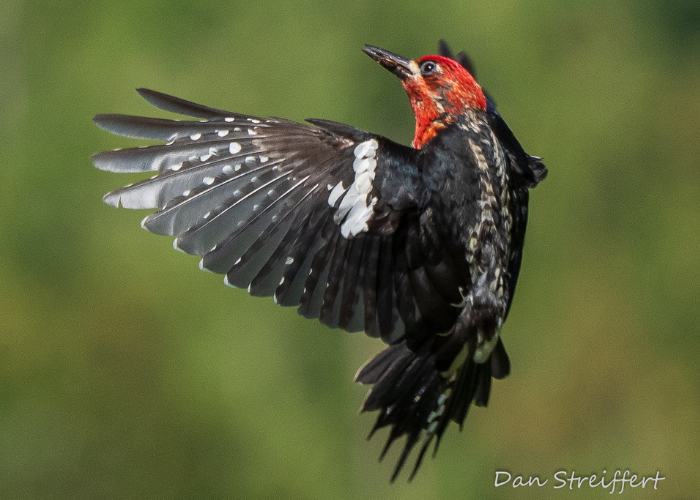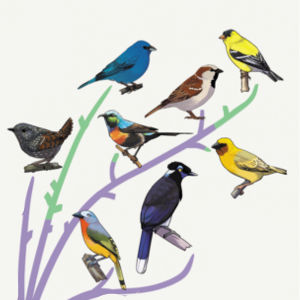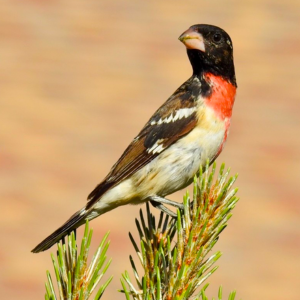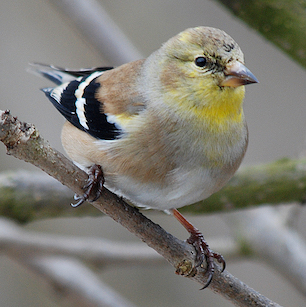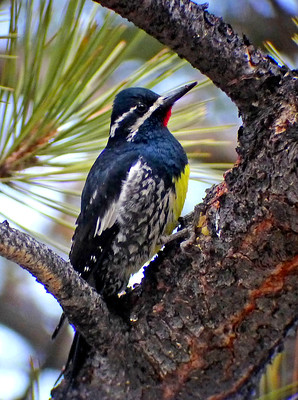
A male Williamson's Sapsucker. Photo by Ken Schneider.
Woodpeckers stand out among birds and not just for their well-known foraging habits, extra-long tongues, and reinforced skulls. The North American branch of the family Picidae also has unusual molt patterns, replacing all primaries and rectrices during preformative and prebasic molts but retaining at least some of their primary coverts and secondaries during these molts. One twig on the North American woodpecker branch, the sapsuckers, stands out even more- in addition to constructing sap wells, these four species take this feather retention pattern even further.
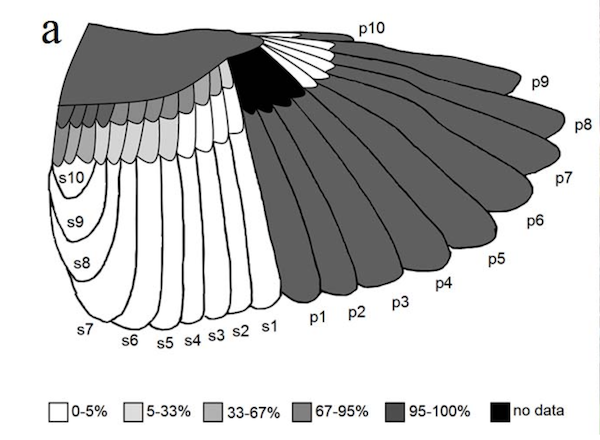
Figure S2 from Pyle and Schofield, 2023. Feather numbering and replacement percentages for each alar feather among 171 formative sapsuckers of all groups pooled
In a study published last week* in The Wilson Journal of Ornithology, IBP biologists Peter Pyle and Lynn Schofield examine molt in sapsuckers (genus Sphyrapicus.) These specialized woodpeckers had been thought to replace fewer feathers during a given molt cycle than other North American woodpeckers, but these differences had not been examined in detail until this study. The researchers then discuss how the timing and extent of molt in five different species and subspecies of sapsucker may relate to migration.
Pyle examined and scored molt in 675 specimens from museum collections and wing photos from sapsuckers banded as part of the MAPS program in the Boreal region of Alberta. Schofield performed statistical analyses to examine correlations between molt extents and time of year for all four species of sapsucker: Yellow-bellied (S. varius), Red-naped (S. nuchalis), Williamson’s (S. thyroideus), and Red-breasted (S. ruber)- the two subspecies of which, S. r. ruber and S. r. daggettii- were treated as separate groups due to their differing migratory strategies.
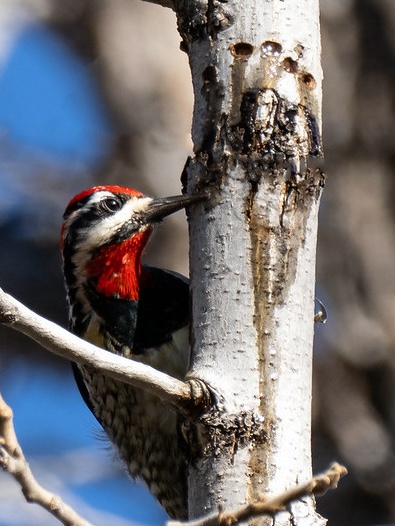
A Red-naped Sapsucker. Photo by Mick Thompson.
The researchers found that on average, sapsuckers do indeed replace fewer feathers per molt cycle than other North American species of woodpecker. Pyle was able to describe sapsucker molt sequences in detail.
“I was pleased to figure out the exact replacement sequences among the primary coverts and secondaries, both convergent from the outside of each tract inward, and terminating in the primary covert that corresponds to p6 of the primaries, and with s3 or s4 of the secondaries,” says Pyle. “Then that the next wave of replacement can begin before the first one finishes is cool. This mimics what we call "Staffelmauser" (or stepwise molt) in the primaries, a process that results in multiple replacement waves and our ability to age large flighted birds such as eagles and condors up to four or five years or greater.”
This study is the first to report the Staffelmauser pattern occurring in the primary coverts of birds but, uniquely to woodpeckers (and kingfishers), not the primaries.
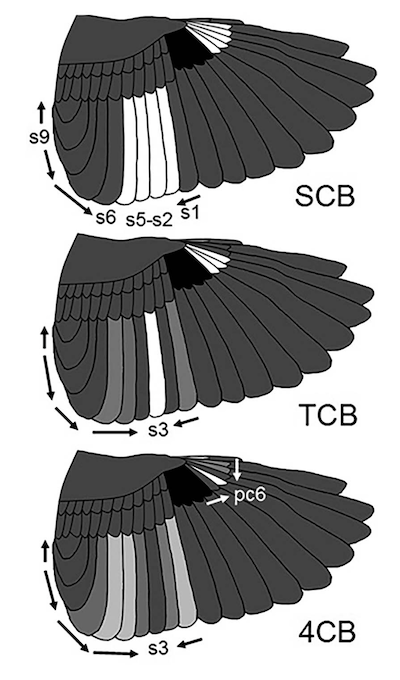
Figure 5 from Pyle and Schofield, 2023 showing progression of molt for a typical sapsucker from 2nd basic to 4th basic plumage.
Pyle found that most sapsuckers do not replace any primary coverts during their second prebasic molt, in comparison to other woodpeckers replacing from 1 to 5 of these feathers at this molt. This means that those retaining all juvenile primary coverts can be either first-year (FCF or HY/SY) or second-year (SCB or SY/TY) birds, and the greater coverts need to be examined to tell these two age groups apart. The slower replacement of primary coverts then carries forth into subsequent prebasic molts throughout the life of a sapsucker, and similar slow replacement occurs within the secondaries. Therefore all sapsuckers in 3rd basic plumage (TCB or TY/4Y) can be identified by retaining at least 2 juvenile primary coverts, those corresponding to p6 and p7. Furthermore, a proportion of sapsuckers in 4th basic plumage (4CB or 4Y/5Y) can be identified by the continued retention of at least 1 juvenile primary covert (corresponding to p6) for at least five years! Only certain species of large owls retain juvenile feathers this long (for example Great Gray Owl). Clarifications of these molt patterns will allow banders and researchers to age sapsuckers more precisely than the criteria presented in the 2022 edition of Pyle’s Identification Guide North American Birds, Part 1. 2nd edition.
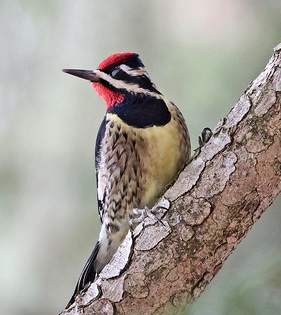
A Yellow-bellied Sapsucker. Photo by Tom Murray.
Pyle and Schofield then explored differences in the timing of molt between the 5 groups of sapsuckers. For the preformative molt, Yellow-bellied Sapsuckers took more time and replaced fewer feathers than the other species. This could relate to the energy constraints of migration and could help first-year birds avoid predation due to the additional camouflage that juvenile feathers afford. However, during later prebasic molts, molt was greatest in Yellow-bellied Sapsucker, followed by Williamson’s Sapsucker, then Red-naped and the dagettii subspecies of Red-breasted Sapsucker. The ruber subspecies of Red-breasted Sapsucker has the least extent of molt in a given basic cycle.

A Red-breasted Sapsucker of the subspecies dagettii photographed by Jaime Chavez in southern California.
The authors propose that these differences in the extent of molt may relate indirectly to migration in the form of variation in solar exposure. The ruber subspecies of the Red-breasted Sapsucker is essentially non-migratory and lives in shady habitats. In contrast, Yellow-bellied Sapsuckers, which exhibit the greatest extent of molt, are migratory and thus exposed to longer daylengths year-round and, hence, greater sun exposure. Solar radiation damages feathers, requiring them to be replaced more frequently. Williamson’s Sapsuckers, which also show a higher extent of molt, are less migratory than Yellow-bellied, but they live in open habitats and at higher elevations, where they are likely subject to more solar radiation.
So, if you’re not a molt enthusiast, why should you care about these seeming minutiae of feather replacement? Because molt and feather age is the best way to age adult wild birds and age is critical for understanding the demographics and health of populations, as well as other aspects of avian ecology that have important conservation implications. For instance, molt analysis allowed researchers to discover age-related dispersal patterns in Black-backed Woodpeckers that have changed recommendations for the management of post-fire forests to conserve this species. The age of birds can also yield insights into habitat quality, as in a 2020 study by Pyle et al showing the segregation of yearling birds into poorer quality habitats.
Molt is a physiologically demanding process that affects a morphological structure- feathers- that are critical for mobility, thermoregulation, and in some cases sexual signaling. And yet avian molt is vastly understudied compared with, say, migration and breeding, perhaps due to poorly constructed and confusing molt terminologies used in the past. However, the differences and commonalities in molt patterns between bird species prompts intriguing research questions on the origin and function of these patterns. A greater understanding of these patterns can yield insights into the ecology and evolution of birds as well as their conservation.
*This study appeared in the December 2023 issue of The Wilson Journal of Ornithology which was on April 9, 2024.



